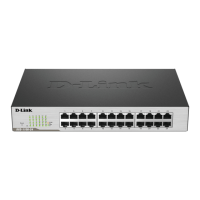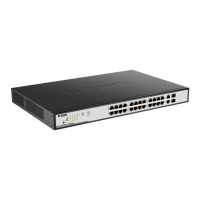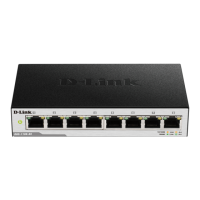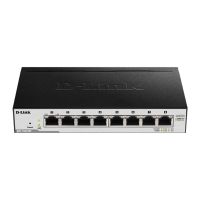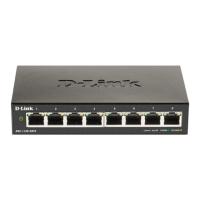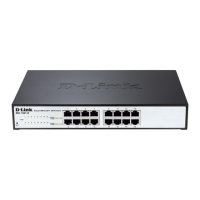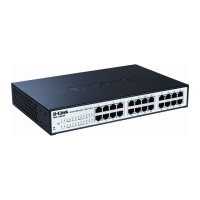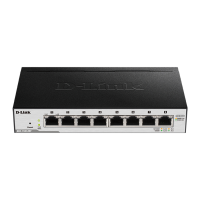Do you have a question about the D-Link DGS-1100-24P and is the answer not in the manual?
Identifies the target audience for the manual.
Lists other related documents for configuration.
Explains document conventions and formatting.
Explains indicators used in the manual.
Details the front and rear panel of the DGS-1100-16 switch.
Details the front and rear panel of the DGS-1100-18 switch.
Details the front and rear panel of the DGS-1100-24 switch.
Details the front and rear panel of the DGS-1100-24P switch.
Details the front and rear panel of the DGS-1100-26 switch.
Instructions for unpacking and checking switch contents.
Covers desktop, shelf, and rack mounting procedures.
Details connecting the AC power cord and grounding the switch.
Overview of management platforms and connecting via web UI.
Steps for logging into the web manager and initial wizard setup.
Displays and configures basic system details like name and IP.
Configures network interface settings for IPv4 and IPv6.
Sets up port parameters, including speed, duplex, and jumbo frames.
Configures Power over Ethernet system, status, and ports.
Configures system log settings and server destinations.
Manages switch time, time zones, and SNTP settings.
Manages user accounts, passwords, and privilege levels.
Configures SNMP global settings, traps, and community strings.
Configures web access and D-Link Discovery Protocol.
Manages forwarding databases and MAC address learning.
Configures Virtual LANs, including 802.1Q and port-based VLANs.
Prevents network loops by managing redundant paths.
Detects and prevents network loops caused by ports.
Configures port priority based on 802.1p values.
Controls bandwidth usage per port.
Protects against CPU flooding and network storms.
Restricts forwarding and prevents DoS attacks.
Configures zone defense and secure web communication.
Tests copper cables for quality and errors.
Displays port traffic statistics and configures port mirroring.
Configures power saving modes like link detection and scheduled shutdown.
Enables energy saving for idle links.
Saves, restores, and backs up switch configurations.
Displays firmware info and manages upgrades/backups via HTTP/TFTP.
Backs up system logs to HTTP or TFTP.
Performs ping tests, resets the switch to defaults, and reboots.
Explains Gigabit, Fast Ethernet, and Switching technologies.
Details switching capacity, forwarding rate, and memory.
Lists operating conditions, EMI, and safety certifications.
Covers port capabilities and major feature categories.
Provides safety instructions for installing equipment in racks.
Identifies the target audience for the manual.
Lists other related documents for configuration.
Explains document conventions and formatting.
Explains indicators used in the manual.
Details the front and rear panel of the DGS-1100-16 switch.
Details the front and rear panel of the DGS-1100-18 switch.
Details the front and rear panel of the DGS-1100-24 switch.
Details the front and rear panel of the DGS-1100-24P switch.
Details the front and rear panel of the DGS-1100-26 switch.
Instructions for unpacking and checking switch contents.
Covers desktop, shelf, and rack mounting procedures.
Details connecting the AC power cord and grounding the switch.
Overview of management platforms and connecting via web UI.
Steps for logging into the web manager and initial wizard setup.
Displays and configures basic system details like name and IP.
Configures network interface settings for IPv4 and IPv6.
Sets up port parameters, including speed, duplex, and jumbo frames.
Configures Power over Ethernet system, status, and ports.
Configures system log settings and server destinations.
Manages switch time, time zones, and SNTP settings.
Manages user accounts, passwords, and privilege levels.
Configures SNMP global settings, traps, and community strings.
Configures web access and D-Link Discovery Protocol.
Manages forwarding databases and MAC address learning.
Configures Virtual LANs, including 802.1Q and port-based VLANs.
Prevents network loops by managing redundant paths.
Detects and prevents network loops caused by ports.
Configures port priority based on 802.1p values.
Controls bandwidth usage per port.
Protects against CPU flooding and network storms.
Restricts forwarding and prevents DoS attacks.
Configures zone defense and secure web communication.
Tests copper cables for quality and errors.
Displays port traffic statistics and configures port mirroring.
Configures power saving modes like link detection and scheduled shutdown.
Enables energy saving for idle links.
Saves, restores, and backs up switch configurations.
Displays firmware info and manages upgrades/backups via HTTP/TFTP.
Backs up system logs to HTTP or TFTP.
Performs ping tests, resets the switch to defaults, and reboots.
Explains Gigabit, Fast Ethernet, and Switching technologies.
Details switching capacity, forwarding rate, and memory.
Lists operating conditions, EMI, and safety certifications.
Covers port capabilities and major feature categories.
Provides safety instructions for installing equipment in racks.
| Switch type | Managed |
|---|---|
| Switch layer | L2 |
| Quality of Service (QoS) support | Yes |
| Power connector | DC-in jack |
| Installed SFP modules quantity | 0 |
| Basic switching RJ-45 Ethernet ports type | Gigabit Ethernet (10/100/1000) |
| Basic switching RJ-45 Ethernet ports quantity | 24 |
| 10G support | - |
| Networking standards | IEEE 802.3ab, IEEE 802.3aq, IEEE 802.3az, IEEE 802.3u, IEEE 802.3x |
| Virtual LAN features | Voice VLAN, Port-based VLAN |
| DHCP features | DHCP client |
| MAC address entries | Static MAC address entries |
| Queue scheduling algorithms | SP, Weighted Round Robin (WRR) |
| Jumbo frames | 9216 |
| Forwarding rate | 35.71 Mpps |
| Number of queues | 96 |
| MAC address table | 8000 entries |
| Packet buffer memory | 0.512 MB |
| Safety | UL/cUL, CE LVD |
| Certification | -FCC Class A\\r -CE Class A\\r -VCCI Class A |
| Product color | Black, Grey |
| Number of fans | 1 fan(s) |
| AC input voltage | 100 - 240 V |
| AC input frequency | 50 - 60 Hz |
| Power consumption (max) | 128.3 W |
| Power consumption (typical) | 21.2 W |
| Total Power over Ethernet (PoE) budget | 100 W |
| Power over Ethernet plus (PoE+) ports quantity | 12 |
| Storage temperature (T-T) | -40 - 70 °C |
| Operating temperature (T-T) | -5 - 50 °C |
| Operating relative humidity (H-H) | 0 - 95 % |
| Noise level | 27.6 dB |
| Flash memory | 8 MB |
| Mean time between failures (MTBF) | 563292 h |
| Package depth | 362 mm |
| Package width | 361 mm |
| Package height | 104 mm |
| Package weight | 3169 g |
| Pallet width | 1100 mm |
| Pallet length | 1200 mm |
| Pallet height (air) | 1330 mm |
| Pallet height (sea) | 2125 mm |
| Pallet gross weight (air) | 306819 g |
| Pallet gross weight (sea) | 499365 g |
| Quantity per pallet (air) | 81 pc(s) |
| Quantity per pallet (sea) | 135 pc(s) |
| Shipping (inner) case width | 334 mm |
| Shipping (inner) case height | 398 mm |
| Shipping (inner) case length | 380 mm |
| Shipping (inner) case weight | 10697 g |
| Shipping (inner) case net weight | 9507 g |
| Number of cartons per pallet (air) | 27 pc(s) |
| Number of cartons per pallet (sea) | 45 pc(s) |
| Quantity per shipping (inner) case | 3 pc(s) |
| Depth | 230 mm |
|---|---|
| Width | 280 mm |
| Height | 44 mm |
| Weight | 2150 g |

